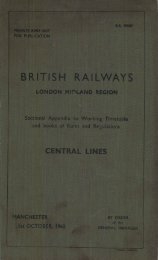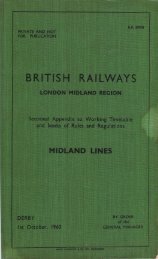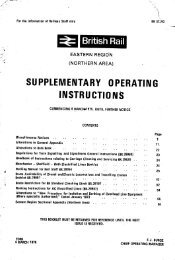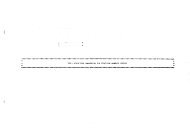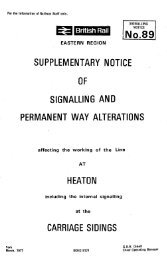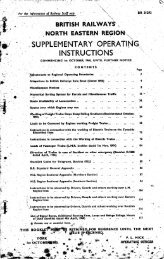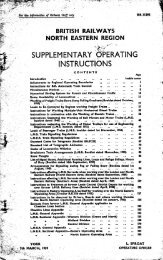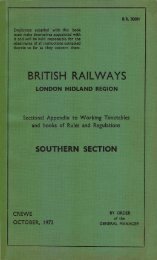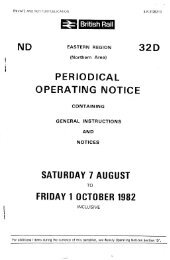general instructions. - Limit Of Shunt
general instructions. - Limit Of Shunt
general instructions. - Limit Of Shunt
You also want an ePaper? Increase the reach of your titles
YUMPU automatically turns print PDFs into web optimized ePapers that Google loves.
22 Extracts from Block Telegraph Regulations for the guidance of Engine<br />
Drivers and others not supplied with a copy of the<br />
Block Telegraph Regulations.—Continaed. I<br />
Single Lines worked by Electric Train Staff and Electric Train Tablet<br />
— Regulation 16.<br />
Continued.<br />
— Note.--An engine driver must not, under any circumstances, foul the single<br />
Fouling<br />
line for shunting purposes, unless he has received the authority of the signalman<br />
to do so.<br />
S i n g l<br />
Regulation 34.A.<br />
e (a) — Points giving communication between the sidings and the main line con-<br />
Ltrolled i by nthe<br />
tabla or staff cannot be opened without the tablet or staff for<br />
Controlling<br />
e that section of the line where the siding is situated, and the tablet or staff<br />
cannot S i be d removed i n guntil<br />
the points have been placed in proper position for<br />
f o<br />
trains s to pass upon the main line, and securely locked so as to prevent<br />
r vehicles passing from the siding on to the main line.<br />
b y<br />
S (b) hOn arriving u at a siding, the points of which are controlled by tablet or<br />
m e a<br />
nstaff tthe engine-driver i<br />
must hand the tablet or staff to the guard or man in<br />
n s<br />
ncharge g of the siding to enable the points to be unlocked. When the necessary<br />
shunting o has been completed, and the points have been placed in the proper<br />
pposition u r<br />
f for trains to pass upon the main line, the guard or man in charge<br />
of p the osiding s must return the tablet or staff to the engine driver, and the<br />
t h<br />
elatter s must . not proceed on his journey until he has obtained possession of it.<br />
e<br />
Regulation K.—Exchanging Staffs or Tablets.<br />
staffs T a<br />
- or train tablets by hand drivers must be careful not to exceed a<br />
speed b l<br />
When<br />
of 10<br />
e<br />
miles<br />
x c<br />
per<br />
h a<br />
hour.<br />
n g i n g<br />
et r t a i n<br />
o SINGLE LINES WORKED BY TRAIN STAFF AND TICKET.<br />
r Regulation 34.—When exchanging Train Staffs by hand drivers must be<br />
careful S not t to exceed a speed of 10 miles per hour.<br />
a f<br />
f . TRAIN SIGNALLING BY RECORDING TELEGRAPH<br />
-<br />
INSTRUMENTS.<br />
Regulation 4.<br />
section — clear but station or junction blocked signal has been received, or the<br />
section<br />
(I)<br />
is<br />
O<br />
already<br />
n<br />
occupied and it is necessary for another train to be sent<br />
forward, the home signal must be kept at danger until the approaching train<br />
has<br />
l<br />
been<br />
i n<br />
brought<br />
e s<br />
to a stand, and the driver verbally instructed to proceed<br />
with w caution. h e<br />
r e<br />
(g) On lines where passenger trains are dealt with, if when a train has been<br />
brought<br />
p a<br />
to<br />
s<br />
a stand at the home signal it is too far away for the signalman to<br />
verbally s e caution n the driver, a green flag or green light must be she wn by the<br />
signalman, g e r which the driver must acknowledge by giving a short sharp whistle.<br />
The t home r signal may then be lowered and the driver must proceed with<br />
caution on the understanding that the advance section is occupied. In such<br />
a i<br />
cases no verbal caution will be given by the signalman.<br />
n s<br />
a(h)<br />
On lines where passenger trains are NOT dealt with when the section<br />
clear but station or junction blocked has been received or the section is already<br />
r<br />
occupied and it is necessary for another train to be sent forward, the home<br />
signal<br />
e<br />
must be kept at danger until the approaching train has been brought<br />
d<br />
e<br />
a<br />
l<br />
t




